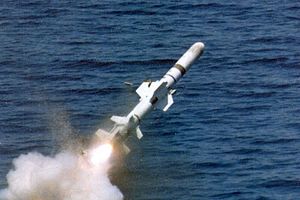The United States began delivering submarine-launched anti-ship missiles to Taiwan this year, according to a new report released by Taiwan’s Ministry of National Defense (MND).
This week the MND delivered a report on U.S.-Taiwanese defense cooperation to the Legislature’s Foreign Affairs and National Defense Committee. According to local media, one of the revelations from the report was that the U.S. began delivering UGM-84L sub-launched Harpoon Block II missiles to Taiwan in 2013.
The U.S. Defense Security Cooperation Agency first notified Congress of a potential deal to sell Taipei the missiles in 2008. Under the terms of the deal, the U.S. will sell Taiwan 32 UGM-84L Sub-Launched Harpoon Block II missiles and 2 UTM-84L Harpoon Block II Exercise missiles for $195.46 million. All of the missiles and support equipment are scheduled to be delivered by 2016.
According to the report, Taiwan will equip its Dutch-built Hai Lung-class submarines with the HARPOON Block II anti-ship missiles.
Focus Taiwan reported that the missiles have a range of about 125 km, which would allow them to reach China’s coasts. This indicates they will be used to try and thwart an amphibious invasion of Taiwan by targeting ships while they are still close to port.
The Harpoon Block II anti-ship missiles are ideally suited for this mission, according to Boeing, which manufactures the Harpoon missile. To begin with, the Block II version of the Harpoon was equipped with upgrades designed to increase its ability to operate in contested areas. Additionally, Boeing’s official description of the Harpoon Block II states that the anti-ship variants’ Global Positioning System/Inertial Navigation System “improves midcourse guidance to the target area. The accurate navigation solution allows users to discriminate target ships from islands or other nearby land masses or ships. These Block II improvements maintain Harpoon’s high hit probability even against ships very close to land.”
Taiwan already possesses air and surface-launched Harpoon missiles. However, this acquisition allows Taiwan to operate anti-ship missiles using the more survivable submarines. The overwhelming majority of anti-ship missiles have been launched from aircraft and/surface ships. Some of the few other anti-ship missiles that can be operated from submarines include the French-built Exocet and a variant of the BGM-109 Tomahawk. This year India successfully test fired a BRAHMOS supersonic cruise missile from a submarine.
The Federation of Atomic Scientists’ explain the procedure used in the sub-launched Harpoons as follows:
“The submarine Harpoon is contained within a capsule and is called ENCAP for encapsulated. The ENCAP is the same size and general shape of a blunt nosed torpedo and is launched from submarine torpedo tubes. It has positive buoyancy (it floats), so when it is ejected from the submarine, it will rise to the surface, without power. The ENCAP consists of a nosecap, main body and afterbody. The missile is on shock isolator rails within the main body. The afterbody has fins which direct the ENCAP towards the surface at the proper angle for missile launch. Once the ENCAP breaches the surface, the nosecap is blown off by a small rocket and the missile is launched.”

































